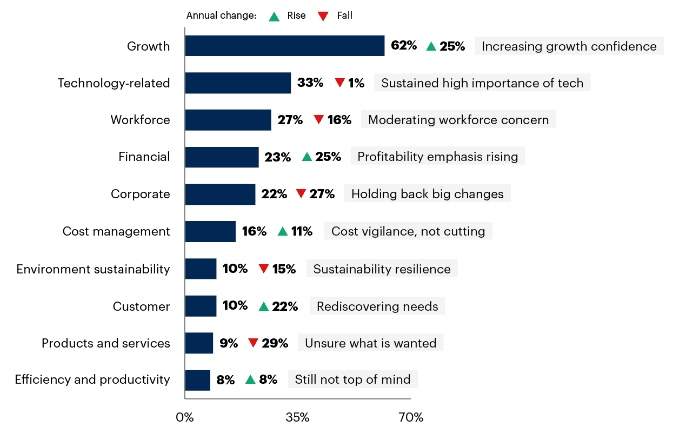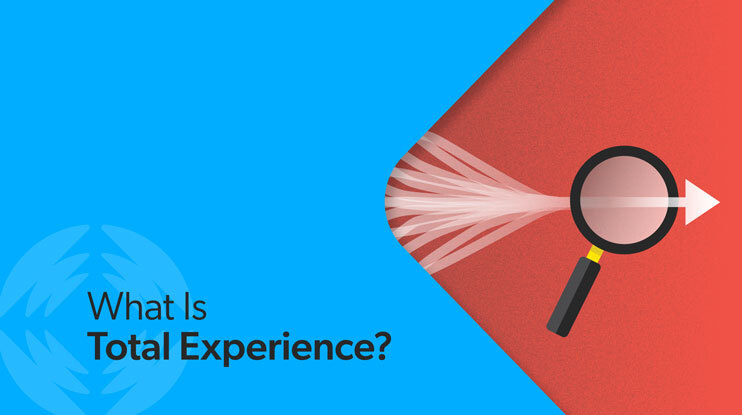A total experience strategy is a business strategy that focuses on streamlining, integrating, and aligning your organization’s overall experience approach via a holistic employee and customer support strategy. The goal is to create a great — and consistent — information ecosystem that addresses the needs of various users by aligning teams and systems that might otherwise exist in silos.
Translated: that means employee experience and customer experience are linked. Harvard Business Review notes that companies that get high grades on employee satisfaction and experience also do well when it comes to delivering good customer experience metrics.
This makes sense. Happy employees make for engaged, informed, and enthusiastic customer-facing teams who excel at delivering good service.
Curious about how to achieve a total experience? Let’s dig in.
What Is a Total Experience Strategy?
A TX strategy combines your organization’s digital experience ecosystem across departments regardless of who they are or how they’re connected to your company. The goal is to create exceptional experiences for everyone.
Total experience connects four experience disciplines, aiming to create one superior shared experience. From Gartner, these include:
1. Customer Experience (CX)
CX focuses on the customer’s needs and delivering a positive experience. It’s about surfacing or exposing content to a searcher either in return for a query or based on customer feedback and profile information to achieve customer satisfaction and brand loyalty.
Example: An ecommerce store provides personalized experiences and product recommendations to a customer based on their search for “helmets” or on historical profile data.
2. Employee Experience (EX)
EX focuses on employee needs and their employee journey within the organization. It’s about empowering employees to quickly find relevant information across multiple data sources and repositories, increasing employee engagement and proficiency.
Example: Your company intranet shows an employee their previous searches and new content related to those searches when they log in.
In this example, you’ve used the employee’s personal information and search history to create a personalized experience and that surfaces relevant insights and information within the company intranet.
Intranets are just one source of information that aren’t built to deliver unified search; with unified and AI-powered search, along with generative AI, you can effectively implement knowledge management in the workplace to enhance your total experience approach.
3. User Interface (UI) & User Experience (UX)
UI focuses on interfaces and navigation. It’s about creating frictionless interaction points to get the user to the end goal quickly — often meaning the organization’s end goals. UX, on the other hand, is more concerned with the emotions your visitor experiences during those interactions. It looks to elevate their overall brand experience. UI and UX need to work flawlessly together to drive customer satisfaction and loyalty.
Example: A user lands on your website after a web search, and the site uses available zero-party and first-party data along with insights from market research to tailor content offerings on the first page they visit. Because they see (and enjoy) content related to them and their search, they’re more likely to stay on the site and explore.
If your company invests in SEO and SEM, on-site search should be a priority as part of your total experience management strategy to ensure customers are compelled to convert.
4. Multi Experience (MX)
MX focuses on various digital touchpoints. It’s about streamlining and optimizing user experience across the digital channels and modalities where interactions can occur: mobile, voice, online, gesture, in-app, etc.
Example: A user contacts a customer support chatbot on their mobile phone, asks a question using natural language queries (through typing or voice input) and gets an answer to their question. This demonstrates effective customer interaction and service.
Total experience brings together CX, UX, EX, and MX by leveraging a digital ecosystem of adaptable platforms, artificial intelligence (AI), data, and content.
Forrester calls this “experience architecture” (XA) and defines it as:
An approach that aligns the enterprise with omnichannel customer experiences enabled by customer-centric business practices , adaptable platforms, and connected employees and partners.
XA brings together all the above to create unified and consistent experiences for all users, regardless of touchpoint. A total experience strategy allows you to understand who the audience is, what they want, and what’s stopping them from achieving that goal. It uses insights from market research and customer feedback to continuously improve the overall experience.
Why Is Total Experience Important?
Seamlessly linking your experience ecosystem reduces customer friction, empowers employees and users, and offers exponential value when it comes to delivering unified communication to everyone who interacts with your business.
According to Gartner, the ‘intertwining’ of experiences is essential because each experience impacts and influences other experiences. This makes it important for many reasons including:
- Increasing customer engagement: By offering — and supporting — multiple channels for interaction, companies engage more with customers in ways that are meaningful, relevant, and personalized to their needs and behaviors. Those behaviors, in data form , create a feedback loop that helps your business grow and enhance the overall brand experience.
- Improving customer and employee satisfaction: Total experience creates a better understanding of the customer journey , allowing companies to identify points where customers are struggling or having difficulty and improve those experiences.
- Empowering employees to better serve customers: It gives your service employees the authority and autonomy they need to address customer issues quickly , mitigate problems, and keep clients happy.
- Growing customer loyalty: Total experience helps build loyalty from customers as they have access to more information in more ways, delivered consistently. It enables them to self-solve issues and stay engaged with your brand.
- Driving company knowledge: By interconnecting experiences, you create a valuable (and accessible) knowledge base that allows employees to learn from each other. This knowledge base can also be used to refine and improve total experiences, identify new opportunities, and mitigate small problems before they become major issues.
By optimizing total experience, companies can ensure that every touchpoint — from the customer’s first visit to their last — is as efficient and effective as possible. This will not only drive more investments in total experience but also help companies stay ahead of the competition and remain poised for growth in 2023.
To do this, of course, you need the right technology and a comprehensive total experience management approach.
Investing in Total Experience Technology
To achieve success with a TX approach, companies need to layer their tech ecosystems with experience architecture like AI-powered search platforms that can create meaningful and tailored experiences for all users.
According to Gartner’s 2024 CEO and Senior Business Executive Survey, growth remains the top business priority for executives. In 2024, 62% of CEOs selected growth as their primary focus, which is the highest level since 2014.

Legacy technology can prevent companies from achieving the agility needed to perform within a largely digital ecosystem. Executives understand that investment is needed in the right technology, processes, and systems to meet their strategic business goals.
There are four core elements to experience architecture, all of which are outlined in a report by Forrester. These include:
1. A cloud ecosystem
A cloud-based ecosystem that serves customers in-the-moment is essential to achieving total experience. It’s the only way to respond to customers and other users wherever they are – across whatever device they’re using. You need a framework that can quickly access and draw from internal and external applications. The best way to do this is via the cloud.
Target is a great example of how multichannel experience and customer experience, when aligned, improve total experience. Target employs a particularly successful omnichannel retail approach using cloud-based architecture that connects over 20 different channels and modes across its entire retail ecosystem. Their legacy system simply could not keep up with the total experience model. Prior to moving to XA, Target had over 3,000 applications that they needed to connect so they could better deliver on the promise of omnichannel experience and enhance overall customer journey.
Target moved their legacy systems to an interconnected cloud-based architecture that uses APIs to move, store, and scale their data and increase development speed. Previously their legacy systems used thousands of applications, the majority of which were tied to mainframes that made it impossible to create the connected ecosystem essential for XA and deliver personalized experiences.
2. Employee empowerment
According to data from ManpowerGroup, 70% of U.S. employers reported talent shortages in 2024, up from 30% in 2009. That’s a talent gap that’s more than doubled in just over a decade. Keeping employees happy increasingly means empowering them with the information they need to do their job. The best way to do that is to make this information accessible across multiple channels. The alignment of EX with CX is another key component to total experience.
It’s as simple as this: great customer experience is connected to great employee experience. Experience architecture that enables employees to work faster and access the resources they need is empowering. It allows employees to do their job quickly and effectively. It translated to higher profits for Volkswagen Group Australia, who found that dealerships that met both CX and EX goals earned double the profit compared with dealerships that didn’t.
3. Customer lifecycle support
The customer lifecycle incorporates many touchpoints and interactions as customers move from one stage to another. According to a Dimension Data report, just 3.7% of businesses claim that CX delivery is consistent across all customer journeys and nearly 70% of businesses say their customer contact approaches are siloed.
There’s a clear disconnect between the type of experiences customers have across their entire customer lifecycle with a business. Total experience architecture can help bridge the gap and streamline experience inconsistencies.
Experience architecture that uses tools like AI-powered search and relevance platforms work to improve experiences by creating a unified view of customer information without siloing data. This allows customers, employees, and other users to access information quickly and easily across multiple channels.
Experience architecture enables companies to connect front-end consumer expectations with back-end operations, allowing you to support customers at all levels and phases of their buying journey and relationship with your company.
4. Futureproof for sustainability
Successful XA must sustain itself for the long term, outliving executive tenure, vendors, and technologies. Sustainability should be baked into your XA strategy so that it can weather disruption from leadership changes, employee attrition, vendor acquisitions, and more.
Per Forrester:
‘To be considered XA, organizations must embed adaptivity and resiliency into it. “We need tech that is reliable and can flex and adapt as consumer demands change,” said the VP of IT at a major clothing retailer. “What is considered best-of-breed tools and apps today will be tomorrow’s baseline.”’
Consider headless and composable frameworks that integrate with legacy and modern technology, so you don’t have to rip and replace.
Achieving Total Experience With Search
An AI search center of excellence combines experts from different teams and with different business functions to spearhead enterprise search functionality within an organization. It helps achieve measurable TX results that impact satisfaction metrics, tying them to key goals like improved net promoter scores. The idea is that this team outlines a search strategy that can adequately serve as a total experience hub across business units. This key component to XA relies on unified search technology to meet the need for flexible enterprise architecture — a need that’s at the forefront of EX and CX transformation.
In a survey of more than 600 tech professionals about the state of their enterprise search initiatives, over 80% said that it was difficult to engage management about search.
Great enterprise search is crucial to improving business processes. While almost all respondents in our survey said their companies had invested in search capabilities to improve results, the right technology is key.
With 30+ integrations and connectors to popular modern SaaS products and a cloud infrastructure, Coveo can be implemented over time and grow with your business. The biggest caveat though is that this requires enterprise-wide adoption. A search center of excellence can help your organization plan and transform over time to get the most out of an investment in AI-powered search, while aligning with your corporate responsibility goals.
With total experience architecture, companies can create experiences that are consistent and unified for users across their organization, no matter their role or lifecycle phase. Relevance platforms like Coveo help bridge the gap between customer touch-points and operations – allowing organizations to create digital experiences that are personalized, agile, and sustainable.
Dig Deeper
Cheap search is expensive! Finding the right information quickly is critical to achieving business results.
In this whitepaper, President of StarCIO Isaac Sacolick explains how AI search can easily drive innovation across your enterprise.
There’s no need for extra developers or third-party plugins.
Keep your customers satisfied and your employees productive with better enterprise search.


